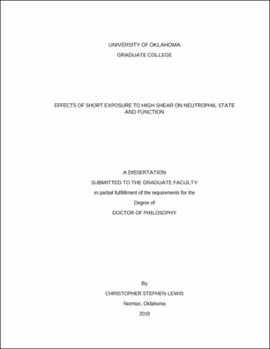| dc.description.abstract | Cardiovascular disease is an ever expanding global issue. Many pathological conditions have been recently linked to elevated local shear rates (>3,000 s-1). Such vulnerable regions have also been found in mechanical support devices such as ventricular assist devices (VADs). Patients in these devices have major life threatening issues regularly, including high infection rates and internal bleeding. Extensive studies with other cell types have found a link between shear rate and exposure time on platelet function, as well as on cleavage of blood-based adhesion molecules. However, very little work has focused on leukocytes. The few studies related to elevated shear on leukocytes demonstrate cause for concern with functional damage after exposures of less than 10 minutes to pathological shear. Neutrophils, as the most abundant leukocyte in the bloodstream, have been the most extensively examined. Studies at physiological shear rates show cell-based changes in actin content and receptor levels. It is also known that shear rate modulates several neutrophil behaviors related to rolling and migration. Despite this, very limited work has been done on the effect of sub second exposures to pathological shears. The work in this thesis aims to address that knowledge gap, by examining the effects of short exposures (<500 msec) to high shear.
In this thesis we present a microfluidic-based study of short exposures to high shear on neutrophil state and function. A microfluidic constricted device was designed and velocity profiles were characterized using a microparticle image velocimetry (µPIV) setup. This setup tracks the positions of small fluorescent particles (1 µm) moving with the fluid, and allows us to characterize the fluid velocity in the channels. Wall shear rates and exposure times were subsequently estimated from these velocity profiles. The majority of the channels used throughout the study have velocity profiles that align well with the expected theoretical values. We also implement a simple glass embeddation technique to reduce channel deformation in the wider channel designs.
We then apply these microfluidic devices to study neutrophil state and function following short exposures to high shear (> 4,000 s-1). Examining neutrophil adhesion and rolling using a P-selectin based assay, we observed increased rolling velocities following transient (< 500 msec) shear exposure. This interaction mimics the initial dynamics of the adhesion cascade, the process by which neutrophils and other leukocytes migrate to sites of infection and inflammation. The magnitude of the rolling velocity increase was dependent upon the high shear exposure time, while increasing the shear rate magnitude lowered the critical exposure time required to observe an increase in downstream rolling velocity. We did not detect any evidence that the increase in rolling velocity results from shedding of the neutrophil ligand responsible for the rolling interaction, PSGL-1. The increased rolling velocities suggest an alteration in neutrophil rolling behavior, which could have an impact on the quantity of migrating neutrophils reaching sites of infection, and thus a decreased ability to fight infection at the source.
Expanding the study to higher shear rates (80,000 – 100,000 s-1), we examined the effect of short exposures (< 73 msec) on both neutrophil state and function. Neutrophils adopt an activated state in response to stimuli, a process which can be defined by (but not limited to) successive changes in surface receptors, released proteins from granules, and intracellular calcium levels. These processes correlated with active neutrophil phenotypes typically occur in a step-wise fashion, although the exact response depends on the applied stimulus. Neutrophil state was evaluated by examining a variety of surface receptor and intracellular granule proteins, which provide us with an idea of the current neutrophil phenotype. We observed a significant increase in the activated form of the surface receptor CD11b, an integrin integral to the adhesion cascade and other downstream functions, and a typical (early) neutrophil activation marker, with exposure times greater than 58 msec. No increases were observed in total CD11b levels, only an increase in the activated conformation. Using flow cytometry, we did not detect any indication of degranulation of any granule subtype. However, we did discover increased levels of the primary granule peroxidase myeloperoxidase (MPO) in both isolated cells and whole blood. In an attempt to examine the cause of the MPO increase, we supplemented the flow cytometry data with confocal imaging. Qualitative analysis suggested a potential aggregation and mobilization of primary granules towards the cell membrane. Examining the cell cytoskeleton, we observed an increase in f-actin content for the 67 msec exposure channel at 90,000 s-1. Finally, we observed decreased functionality as measured with a phagocytosis assay. We saw a significant decrease in all sheared samples compared to the unsheared control, with further decreases corresponding with increased exposure times. The results described throughout this thesis suggest an alteration to neutrophil state, as well as neutrophil dysfunction, after short exposures to high shear. The neutrophil state appears to consist of a primed phenotype, which means that we see partial sign of activation. We suspect the cumulative effect of these shear based changes to reduce the neutrophil’s ability to migrate to, and protect against, infections. | en_US |
